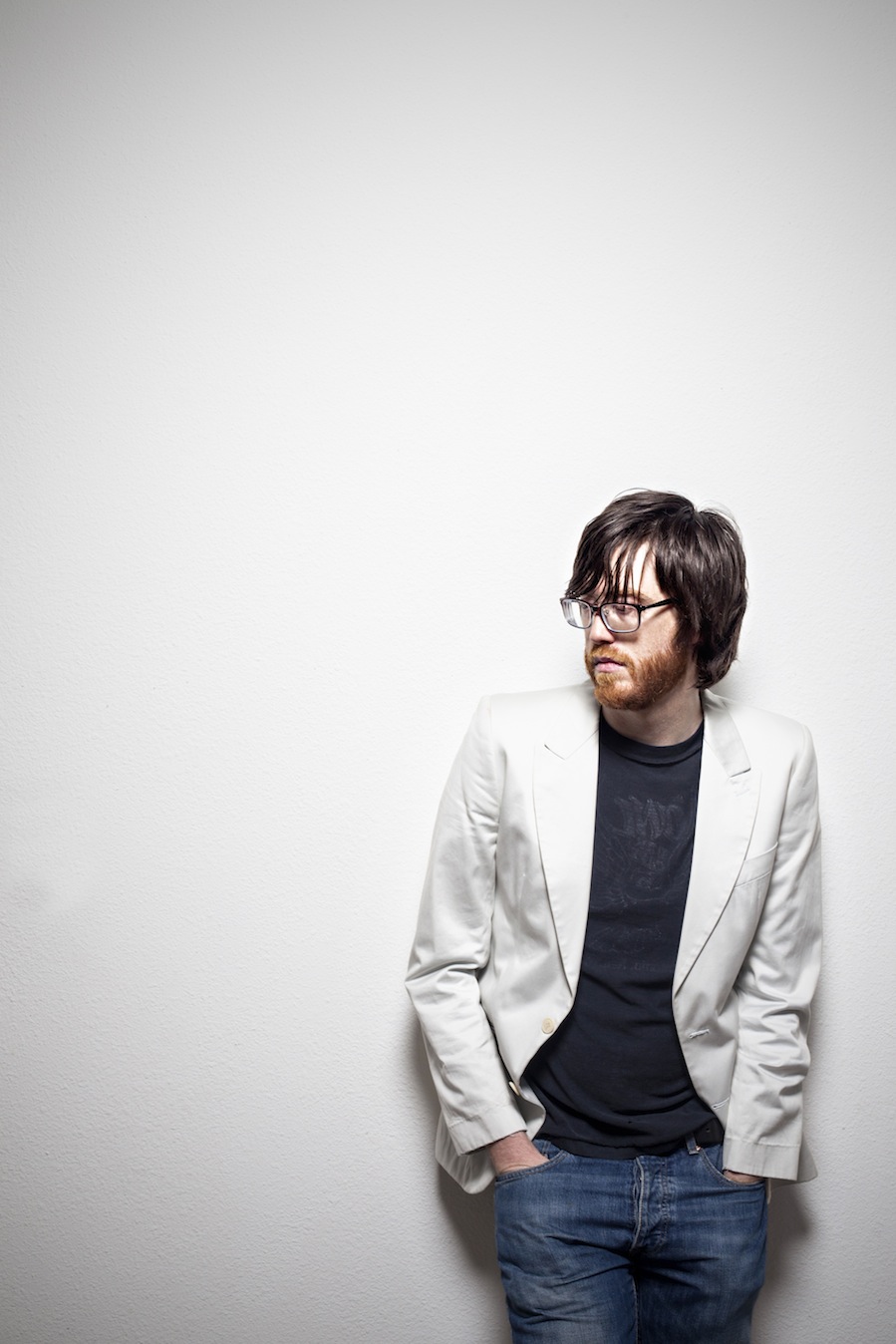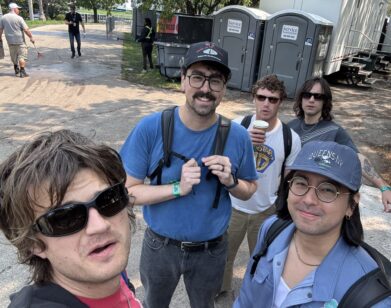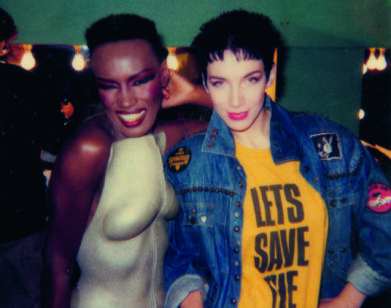Sound of Silver: Will Sheff x William Schaff
Will Sheff, the frontman and songwriter of Okkervil River, and artist William Schaff are often confused for each other. Their similar names brought them together initially, but that was just an amusing start to an artistic collaboration and a friendship that have lasted nearly 15 years. Their process of creating album art has become a routine over the years, but for Okkervil River’s seventh LP, The Silver Gymnasium, out today on ATO, they mixed things up both sonically and artistically.
Sheff is no stranger to concept albums, but this time he changes the focus from the world of an imagined protagonist such as the Black Sheep Boy to his own experiences as a boy growing up in small-town America in the mid-’80s. The sonic landscape of this record is also atypical for Sheff—Casiotone keyboards, synthesizers, and ethereal glass harmonica tones—and this is certainly the first Okkervil River album that inspires Springsteen arm swings à la “Dancing in the Dark.” Artistically, the artwork for the record reaches new heights as well. In addition to his signature cover art, Schaff also created a lovingly detailed map of Sheff’s hometown of Meriden, New Hampshire, around which the album is based.
The world of The Silver Gymnasium is vivid, engaging, and childlike, evoking an era in which technology meant 8-bit Atari video games and VHS tapes, not being virtually tethered in cyberspace. The music and the art seem to communicate with each other—the map enriching the story behind the songs and the lyrics speaking to the colorful places brought to life in the map—as if Sheff and Schaff imagined this world together as 10-year-old boys and created it together decades later.
KRISTINA ENSMINGER: I know that you two have a ritual in terms of how you approach the art for each record. Since this album is more personal, and so closely tied to a specific place and time, how was the process different?
WILL SHEFF: I usually play the songs for William solo; sometimes I’ll send him demos, and we’ll talk about the philosophy behind the songs, the concept, and the art. In the past, I’ve always gone to visit him in his studio in Warren, Rhode Island, but this time he flew to Austin to hang out with us in our rehearsal space.
WILLIAM SCHAFF: So much of my life is spent sitting in my studio, digesting and revisiting things I’ve done in the past as I’m creating new stuff, so it was a very different experience for me to be in your setting. You’ve always come to visit me and immersed yourself in my nest while we figure out the art, but this time I was able to immerse myself in yours.
ENSMINGER: Was your approach any different since you were sharing personal experiences from your childhood?
SHEFF: When you’re a songwriter, people wonder about your personal life and the meanings behind the songs, and that can feel pretty invasive, so you become protective about your inner world. But William gets the unfiltered version of the material that goes into the record. He hears all of my hopes and fears, all of the secrets—the juicy stuff.
SCHAFF: There was something different about hearing you recount the stories behind this record. You’ve always approached all of your albums with passion and excitement, but on this one, whether you were talking about The Last Starfighter or the video store, you were telling me stories about being a kid, and there’s a different passion in that.
ENSMINGER: Does having that kind of intimate access make it easier for you to figure out what you’re going to create from an artistic perspective, William?
SCHAFF: Not at all [laughs]! If anything, working with Will is more nerve-wracking than anything, because he’s more than just a client, he’s a friend, and I don’t want to let him down. If you create anything for someone you care about, you want to make sure they really like it. So this being such an intimate album for him, it actually made it a bigger challenge for me.
ENSMINGER: So your friendship challenges your collaboration in a good way; it inspires you to create something of a higher standard?
SHEFF: Absolutely. I think the personal connection between us really enriches the art. Collaboration is such a thrill when you’re working with someone you really respect. When it’s just one person working alone you get a singular view of their world, and that can be great, too. But when you have different people working together with different aesthetics, different techniques, and different mediums, you get something bigger than both of them.
ENSMINGER: Since William’s art has defined the band’s aesthetic since the first album, the art and the music have a kind of symbiotic relationship. And I think the audio and the visual elements for this record work together in a way that’s really unique. The map creates an interactive element where you can follow along with the journey and see which places inspired each song—revealing another layer to the world that’s introduced on the cover.
SCHAFF: I have all of the Okkervil River records hanging on the wall in my studio, and I just realized that this is the first album where you get to see a landscape. All the other pieces, you’re focused directly on the subject of the image. But with this one, you get a bigger picture and a surrounding landscape, and then you have the map inside, so you really are inviting the viewer into a world.
SHEFF: That’s an interesting point. I hadn’t thought about it that way, but that’s really the focus of The Silver Gymnasium. That’s why all of these videos and art pieces have worked so well, and come so easily, because it’s one big, sprawling world. I’ve always been drawn to the idea of a huge artwork like this, something that combines a lot different pieces into a greater whole.
ENSMINGER: What does the number 13 on the map represent? It doesn’t correspond to a song number, and it isn’t listed on the key.
SHEFF: That’s an answer that will become apparent to anyone who purchases the vinyl. The track [“From a Cutlass Cruiser”] is really important to the record, but all of the songs have different shapes, and when you start Tetris-ing them around sometimes things don’t fit. So this song didn’t really fit with the others, but it’s kind of the key to the whole album, so I set it aside as a bonus track.
ENSMINGER: On a few of the tracks, like the Q&A on “All the Time Every Day” and the advice in “Stay Young,” it felt like an older version of you from the future speaking to your past self. Was that something you thought about as you were writing?
SHEFF: I think about that kind of stuff a lot. It’s a quantum physics thing, where in theory that 10-year-old version of me is still happening—he’s out there somewhere being himself and making mistakes. So there’s a certain amount of trying to talk to that kid and send a message back through time. And that’s probably part of the reason I was so intent on making this album compassionate and approachable and friendly.
ENSMINGER: How do you think kids from a younger era will respond to the record?
SHEFF: I’m actually working on this video where I’m casting a bunch of [pre-teen] kids, and their concept of the ’80s was hilarious to me. It reminded me of how we thought of the ’50s as Stand by Me when we were growing up—that era seemed a million years away to us. When the kids were in my hometown and I was showing them the Maxfield Parrish stage set [at Plainfield Town Hall], I said, “Kids, this is from 1916,” and they said, “1916? That’s even earlier than the ’80s!”
SCHAFF: The album is so centered in that period of time, a lot of the references and the overall feeling. I’m curious to see how younger kids—kids of the ’90s or even later—respond to it. I’m sure there’s a commonality that will come through, but I’m curious to see how they relate to it.
ENSMINGER: Was the music you listened to as a kid a source of inspiration?
SHEFF: I remember the way I felt about Hall & Oates and Genesis when I was a kid. It was music that my parents listened to, and I love music that makes me think about my parents hanging out with their friends drinking piña coladas and Harvey Wallbangers. There’s something sweet and nostalgic about that.
ENSMINGER: What are your feelings about nostalgia—personally or creatively?
SHEFF: I have complicated feelings about nostalgia. I think that sometimes it can be dangerous. It can airbrush the truth, or fictionalize the truth, which leads to the worst kind of sentimentality. But I’m also a sentimental person who feels quite a bit of nostalgia. I feel like writing this album was a way to immerse myself in it, and get past the part of my personality that tends to be melancholy; it was a way to celebrate the good parts of the past. There’s also something really special about childhood. When you’re a kid, you’re at your most creative, and you’re very plugged into your imagination and emotions. But when you get older, you’re encouraged to dance around your feelings and disengage, and I think it’s crucial to fight that. So I wanted to draw a line from being a kid and having all those feelings to becoming an adult and still being engaged with the world on that spiritual and creative level.
SCHAFF: I think Will made a great point about how nostalgia can be dangerous. But I’m also very sentimental and I appreciate the value of the years gone by. I look at nostalgia like alcohol: it’s a good thing to have in your life, and you should enjoy it, but it can be abused and push you into a place where you’re just not paying attention to what’s going around you. And that’s dangerous.
OKKERVIL RIVER’S THE SILVER GYMNASIUM IS OUT TODAY. FOR MORE ON THE BAND, PLEASE VISIT ITS WEBSITE. FOR MORE ON ARTIST WILLIAM SCHAFF, PLEASE VISIT HIS WEBSITE.







